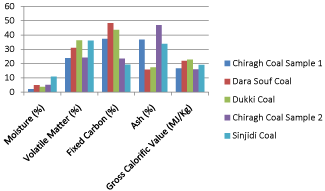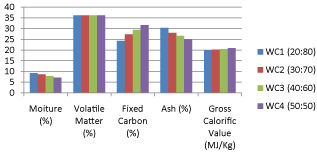
Research Article
Austin Chem Eng. 2017; 4(1): 1048.
Proximate Analysis of Low and High Quality Pure Coal and their Blends from Pakistan
Omar QM¹, Umar S²*, Ahmad M², Fatima S² and Javeed A¹
¹Institute of Chemical Engineering and Technology, University of the Punjab Lahore, Pakistan
²Department of Chemical Engineering, NFC Institute of Engineering and Fertilizer Research Faisalabad, Pakistan
*Corresponding author: Umar Shafiq, Department of Chemical Engineering, NFC Institute of Engineering and Fertilizer Research Faisalabad, Pakistan
Received: March 02, 2017; Accepted: April 10, 2017; Published: April 17, 2017
Abstract
In this work proximate analysis of low and high grade pure coals and their blends has been performed. The coal samples contained Chiragh Coal, Dara Souf Coal, Dukki Coal, and Sinjidi Coal, and their blends with different compositions were subjected to the proximate analysis and the comparison of different properties including moisture content, volatile matter, fixed carbon, ash contents, and gross calorific values has been studied. The proximate analysis has been done according to ASTM standards i.e. ASTM standard D3173-03 for moisture, ASTM standard D3174-04 for ash and ASTM standard D3175-02 for volatile matter and fixed carbon. Gross Calorific values of pure coals and their blends have been determined according to ASTM standard D5865-04 by using bomb calorimeter.
Keywords: Proximate Analysis; Coal Blends; Low Grade and High Grade Coal Blends
Introduction
Coal has currently become a major source of power generation. Pakistan has one of the biggest coal reserves of the world approximately 185 billion tones. The coal reserves are widely present throughout Pakistan but most of the coal is low grade [1]. The energy crisis plaguing Pakistan has renewed interest of the intellectual community in utilization techniques of indigenous coal, both high and low grade, one of which is coal blending. Coal blending has been adopted in power stations of energy sectors, as natural sources of coal are getting depleted day by day due to increasing demand of all energy producing fuels. Coal-fired power plants are designed to burn coal of defined characteristics, usually indigenous coal or coal that is costeffective. However accessibility of coals has changed, so coal-fired plants must use coals that are available to them. The performance of these coals may differ from the design specifications to such an extent that blending becomes essential to reduce the detrimental effects on the plant [2]. Coal blends analysis indicate that blending of low grade coal with high grade coal can produce such a coal which can produce more energy per unit consumed. Coal blends gives such auspicious properties such as less moisture content and high volatile matter and this results in a higher calorific value fuel with higher energy density. It is likely that, globally, at least 20% of power plants, probably significantly more, cannot achieve design output due to difficulties in sourcing coals which consistently meet boiler requirements [3]. This could be resulting in a reduction of 10% or more in potential output from the plants. Recently in Pakistan, Sindh Engro Coal Mining Company is working on Thar coal project and it aims to supply 1200 MW of energy by the end of 2017. All the new projects based on imported coal should be subject to blending with Thar coal at least 20% to scale up mining at Thar [4]. By optimizing blending to provide consistent fuel stock, plants can increase their power output while reducing negative effects on the plant (such as corrosion and fouling) and potentially reducing the emissions of pollutants of concern. Blending decisions should be based on the knowledge of the specific behavior of a given pair of coals, rather than an assumption of linear variation of properties with blend traction. This work concentrates on proximate analysis of coal in pure as well as in form of blends. So this work plays an important role in saving our natural resources and in meeting industrial energy requirements by providing such mother feed for use which will generate more energy with less consumption.
Experimental Work
Coal samples of Dukki (high grade) and Chiragh (low grade), Dara Souf Coal, and Sinjidi Coal were subjected to cleaning. After that, all the coal samples were dried and feed was prepared by grinding them in End runner mill. Coal samples were mixed in different ratios presented in Table 2. Firstly, coal samples were analyzed for properties like moisture content, volatile matter, ash Content and fixed carbon. After that, coal blends samples were subjected to Bomb Calorimeter test for the determination of their Gross Calorific Value (GCV). The value of GCV and Proximate Analysis are the parameters used for identification of the best coal blend with higher heating value.
Coal Blends
Composition (%)
Dara Souf Coal (%)
Chiragh Coal Sample 1 (%)
WA1 (90:10)
90
10
WA2 (70:30)
70
30
WA3 (60:40)
60
40
WA4 (55:45)
55
45
Dukki Coal (%)
Chiragh Coal Sample 2 (%)
WB1 (20:80)
20
80
WB2 (30:70)
30
70
WB3 (40:60)
40
60
WB4 (50:50)
50
50
Dukki Coal (%)
Sinjidi Coal (%)
WC1 (20:80)
20
80
WC2 (30:70)
30
70
WC3 (40:60)
40
60
WC4 (50:50)
50
50
Table 2: Percentage Composition of Coal Blends.
For the determination of moisture content in the coal sample, it was first placed on a petri dish and then in Oven for half an hour at temperature of 100-110 0C. For the determination of Volatile Matter, as they are evolved at high temperature, the coal samples were placed in crucibles and covered with caps. After that, the coal samples were placed in the Muffle Furnace for seven minutes at a constant temperature of 950 0C. After passage of the required time, the samples were taken out and difference in the weight of samples gave the volatile matter in the samples. For ash contents in coal samples, they were placed in the crucible and weighed. They were then placed in Muffle Furnace at 725 0C for 3 hours. The samples were taken out after the specified time and weighed with the difference in the weight of the samples indicating the ash contents of samples being analyzed. Fixed carbon is determined by removing the mass of volatiles determined by the volatility test from the original mass of the coal sample. GCV of all coal samples was determined using bomb calorimeter according to ASTM standard D5865-04 and is presented in Figure 1. All results are shown in Table 1. Moisture content was determined according to ASTM standard D3173-03 [5], ash was determined according to ASTM standard D3174-04 [6], and volatile matter according to ASTM standard D3175-02 [7].
Moisture (%)
Volatile Matter (%)
Fixed Carbon (%)
Ash (%)
Gross Calorific Value (MJ/Kg)
Chiragh Sample 1
1.98
23.79
37.32
36.8
16.61
Dara Souf
4.95
30.95
48.4
15.7
21.81
Dukki
3.7
36.3
43.6
17.4
22.79
Chiragh Sample 2
5.1
24.1
23.5
47
15.98
Sinjidi
10.8
36.07
19.21
33.8
19.2
Table 1: Proximate Analysis of Coal Samples.

Figure 1: Proximate Analysis of Pure Coal Samples.
Results and Discussions
The proximate and ultimate analysis shows a significant deviation in the coal composition this is actually due to we collect the sample from different mines located in Pakistan although their names are same but each sample distance from other sample location is about 70Km therefore a reasonable different in coal composition is observed that shows that both good as well as low quality coal is available in Pakistan and we can use them as an environmental friendly coal in the form of different blends.
The results of proximate analysis of coals in their pure form and different blends are shown in Table 1, and Table 3. The results shows that in the pure form the Dukki coal has highest gross calorific value while the Chiragh sample 1 has lowest value while in case of fixed carbon contents the Dara Souf coal has maximum fixed carbon contents while the Sinjidi coal has lowest fixed carbon content. If we compare the coal samples on the basis of both maximum calorific value as well as fixed carbon contents than Dara Souf sample has almost both maximum values while the Sinjidi has both lowest values of fixed carbon as well as gross calorific value.
In case of blended form the results shows that the in all three different blends including (Dara Souf + Chiragh sample 1), (Dukki + Chiragh sample 2) and (Dukki + Sinjidi) samples the WA4, WB4, and WC4 blending ratios are found to be with maximum fixed carbon and gross calorific value while the WA1, WB2, and WC3 blending ratios are found to be with lowest fixed carbon and gross calorific values. The results were also compared by the graphical methods and shown in Graph 1, 2, and 3.
Coal Blends
Moisture (%)
Volatile Matter (%)
Fixed Carbon (%)
Ash (%)
Gross Calorific Value (MJ/Kg)
Dara Souf Coal + Chiragh Coal Sample 1
WA1 (90:10)
4.7
31.07
48.6
15.63
21.9
WA2 (70:30)
4.21
31.52
49.3
14.96
22.22
WA3 (60:40)
4.14
31.82
49.76
14.28
22.44
WA4 (55:45)
3.98
32.03
50.1
13.88
22.6
Dukki Coal + Chiragh Coal Sample 2
WB1 (20:80)
4.54
27.1
28.3
40.01
17.31
WB2 (30:70)
4.18
29.5
33.1
33.12
17.98
WB3 (40:60)
3.8
31.9
35.9
28.16
18.6
WB4 (50:50)
3.31
34.8
39.4
22.2
19.37
Dukki Coal + Sinjidi Coal
WC1 (20:80)
9.18
36.12
24.32
30.37
19.9
WC2 (30:70)
8.58
36.15
27.29
27.98
20.19
WC3 (40:60)
7.81
36.17
29.41
26.59
20.43
WC4 (50:50)
7.1
36.21
31.66
24.98
20.86
Table 3: Proximate Analysis of Coal Blends.

Graph 1: Proximate Analysis of (Chiragh Coal Sample 1 + Dara Souf Coal)
Blending.

Graph 2: Proximate Analysis of (Dukki + Chiragh Coal Sample 2) Blending.

Graph 3: Proximate Analysis of (Dukki Coal + Sinjidi Coal) Blending.
Conclusion
From this research work it has been concluded that the in pure form Dukki Coal and in blended form out of all possible compositions (Dara Souf + Chiragh Coal Sample 1) found to be more suitable for its use in boiler and thermal power plants for combustion purposes as it has highest possible gross calorific value and lowest moisture contents.
References
- Hussain A, Ani FN, Darus AN, & Ahmed Z. Thermogravimetric and Thermochemical Studies of Malaysian Oil Palm Shell Waste, JurnalTeknologi, 2012; 45: 43-53.
- Xuefeng Z, & Wen-zhuo X, The Study of the Experiment and Preparation with Blending Characteristic in Power Plant, In Consumer Electronics, International Conference on Communications and Networks. 2011; 896-899.
- Petrocom Energy Limited.
- sindh engro coal mining company.
- D3173-03 in Standard Test Method for Moisture in the Analysis Sample of Coal and Coke.
- D3174-04 in Standard Test Method for Ash in the Analysis Sample of Coal and Coke from Coal.
- 3175-02 in Standard Test Method for Ash in the Analysis Sample of Coal and Coke from Coal 2004.